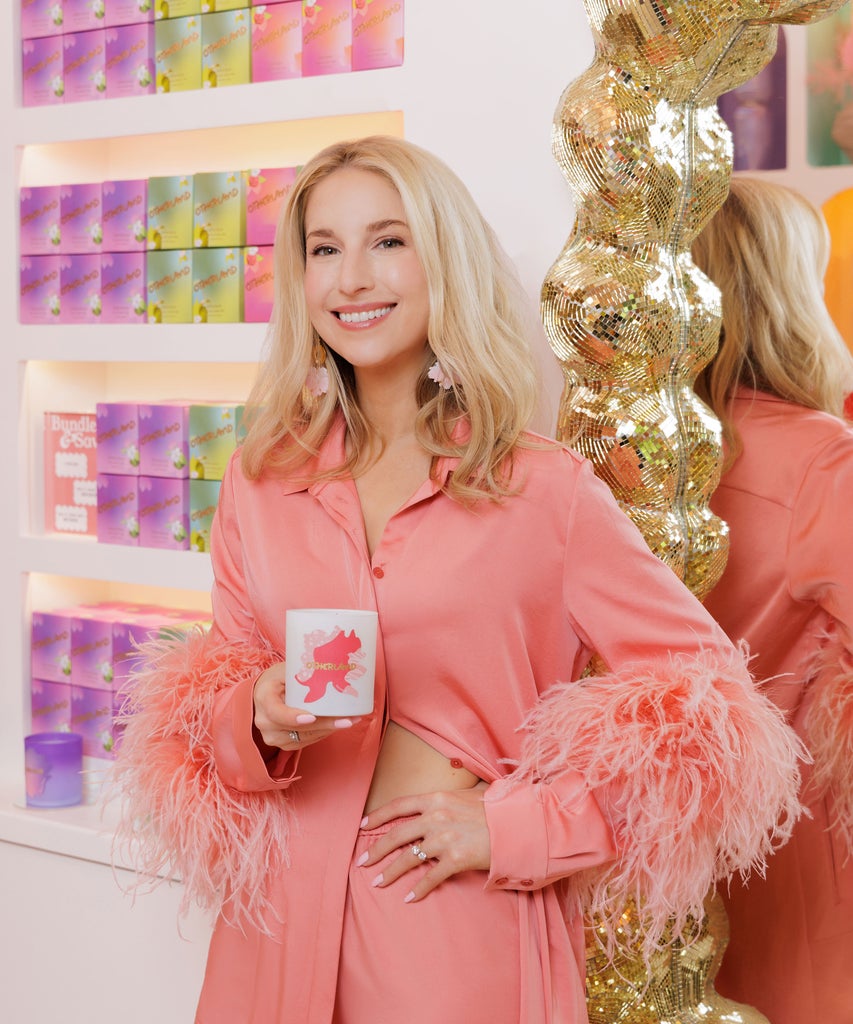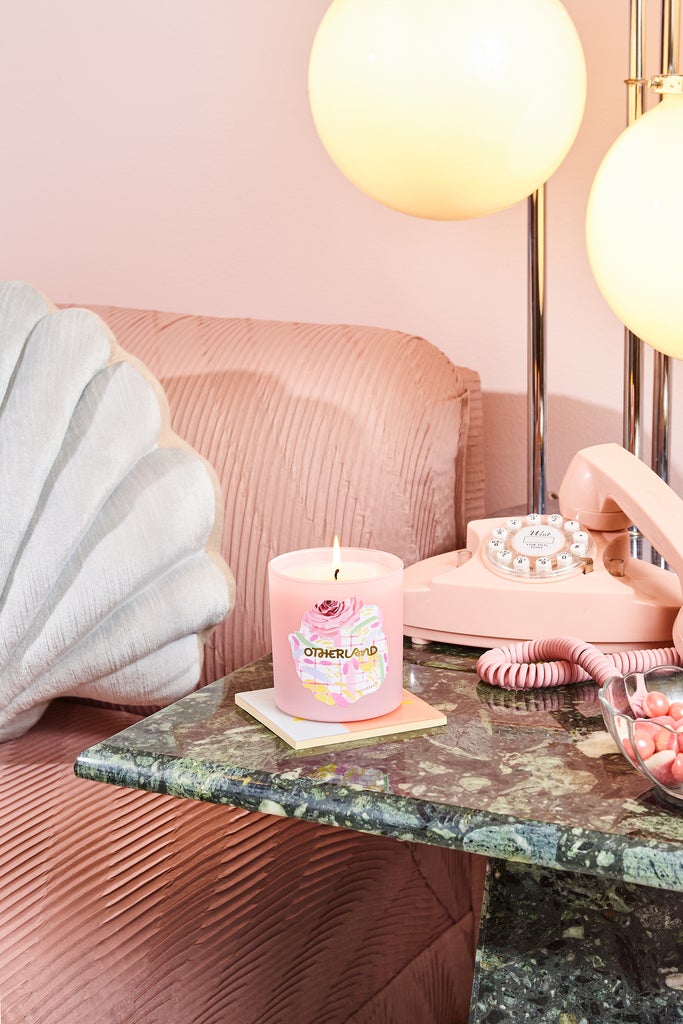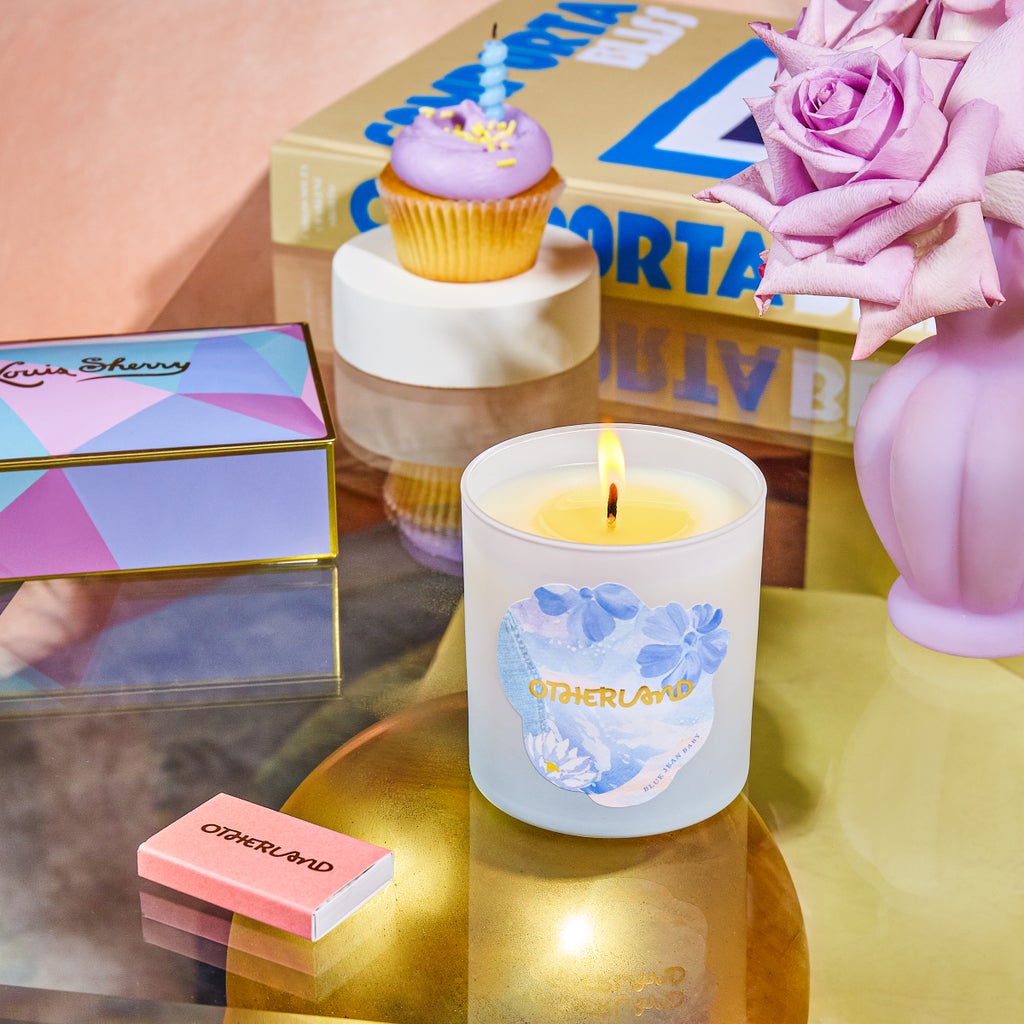
In Refinery29’s Talking Shop series, we’re chatting with owners of up-and-coming small businesses about their experiences launching, the big challenges and wins they’ve faced, and, of course, their products and services.
From the moment I set foot into Otherland‘s cozy SoHo boutique, it was as if I was transported into Abigail Cook Stone’s brain. The co-founder and CEO of the candle startup all over your social feeds had transformed the entire space to be a living, breathing interpretation of the brand’s Carefree ’90s collection — complete with circa-1998 American Girl magazines lining the walls and a (somehow still) functioning pink iMac greeting customers. Scents are invisible by nature, but Otherland made it such a powerful sensory experience that I may as well have been rolling right there at nine in the morning.
That said, you don’t need to stop by the NYC location to see what I mean when you burn an Otherland candle. From the unique, vibrant scents to the colorful frosted glass votives to the artist-designed labels, the brand’s signature candles are a treat for all five senses. (Literally: Stone had brought homemade vegan Pop-Tarts to the event.) In our latest installment of Talking Shop, we sat down (virtually) with Stone to talk all things startup and what led her to build one of the most innovative candle brands in the market.
I would love to hear about your professional journey leading up to Otherland. Did you always see yourself becoming an entrepreneur?
I was definitely the kid who had all kinds of businesses: I had the lemonade stand. I had a dog walking and dog exercising business called Biscuits Incorporated. And I did toothbrush bracelets, which were like a cool thing in the ’90s. We would sell them at school fairs and had a sign for it in that Curlz font [from Microsoft Word]. We would go to a local bakery and get them to give us boxes that we could use as little display risers. So I was always kind of in the entrepreneurial spirit as a kid.
Love it. What was your first job out of college?
I studied art history, and when I graduated, I got a job working at Rugby.com in the Ralph Lauren corporate office. At that point, I was still very interested in this idea of a startup, and I thought I really wanted to be a buyer from my experience at Rugby. I set my sights on that dream, and as I got into the corporate office and got my life set up in New York, it was a painful process in which I realized that this was not the role for me. I realized that fashion really wasn’t what I was passionate about. Where do I go from here? I ended up getting a job working at Ralph Lauren in the art acquisitions department, which was really cool; this was buying artwork for the stores and showrooms. My last project was the Polo Bar restaurant, and this was definitely really fun and super creative — completely different from being a buyer.
But then, I then realized I do kind of miss the business part of it. At this point, I didn’t know anyone who worked at a startup. I had no idea how to access this world. So I started listening to podcasts about startups, and that was really my first introduction. I tried to absorb as much information as I could, and I remember taking like a lot of notes from that. I decided to try my hand at getting into business school and got into Columbia. That provided an opportunity for me to really grow my network and learn a number of things about running a business that my degree in art history hadn’t covered.
It was there that I started working in venture capital for a year, which had some [overlap] with e-commerce. We got to meet a lot of direct-to-consumer brands, and I met so many inspiring founders that were very much part of the startup community at that time. And that’s when I had my big idea.

You had your lightbulb moment — now what was the process of getting the brand off the ground?
I was in my last semester in business school, and at that point, I realized, I’m burning candles every day. I wake up in the morning, I do my meditation on the Headspace app, I light a candle. I come home after work, exhausted, plopped down on the couch, turn on the TV, light a candle, and suddenly it’s “me time.” I loved the transformative power of candles and scents, but I felt like there really wasn’t a brand out there for me. In the market, you had these new luxury brands, $65 and up for 8 ounces, and they had these really fresh, sophisticated, nuanced fragrances — but they were so prohibitively expensive.
I felt like if I could afford to buy one, but I was afraid to burn it. It would sit there like on my coffee table collecting dust, and I would feel kind of silly about that. And then on the other end, you have the value brands: A lot of them really have these artificial, sweet, very saccharine scents and lackluster designs. It felt like there was a middle space where it turned out we could actually work with the same luxury perfumers as the luxury brands, but do it at a much more accessible price [for the customer]. And then I thought, what about bringing art into it? It was the idea of seeing a candle as this consumable experience and multisensory experience. Why can’t we take on the visuals of a candle a bit more?
Once you knew you wanted to make candles, how did you get started?
I went out and bought one candle from as many brands as I could find. I smelled as many as I could. I’d literally pack my tote bag and go to my friends, I’d go to bars and talk to people. I didn’t keep the idea to myself; I think that’s a really important thing. You’ve gotta talk to everyone you meet: What do you think of this? Do you like the lid on this? What brands are you buying? What makes a good candle? I was asking my Uber drivers this! Then, I bought candle-making supplies, and I turned my tiny little kitchen into a candle laboratory. I learned so much about the manufacturing process then, that it gave me the confidence to go out and have a conversation with the owner of a factory about their practices and so forth.
When you combine this vision with a market opportunity, that’s where I was like, I think I really have something here. From there, you put together the pitch and the business plan and figure out the first steps to create this minimum viable product to get the business going.

“Scent is the strongest trigger of memory and emotion — how can we play into this? How can we take you back to the ‘90s? How can we remind you of your favorite sport or that fabulous cocktail you had on vacation last summer?”
abigail cook stone, otherland founder & ceo
Thank you for sharing all of that. Tell us how you went about funding the business in the early stages.
I had worked in venture capital for a year, but I still felt really intimidated by the pitching process and asking for money. An entrepreneur who I really admire said to me, “You need to remember and keep continually reminding yourself: You’re not asking for money. You’re offering investors a chance to get rich on your rocket ship.”
I think deck skills are something that I wish I had learned more earlier — having that great pitch deck, one that’s designed beautifully and that communicates in a really clear way, is very important. After several months of this, someone said yes. From that initial check, we were able to get some of the branding and design work done. Then we could call manufacturers, then people get really excited.
During the pandemic especially, people really invested in their home being their haven. How do you approach making a product that people have in their most personal spaces?
My thought and approach to candles is it’s a candle — you know, it should be fun. It doesn’t need to be this serious thing. Scent is the strongest trigger of memory and emotion — how can we play into this? How can we take you back to the ‘90s? How can we remind you of your favorite sport or that fabulous cocktail you had on vacation last summer? How can we be a brand that really encompasses that joy? We express our optimism very much through the celebration of color, pattern, and texture. With other brands, minimalism has prevailed in a lot of ways, but you’ve also landed with a market of candles where a lot of the stuff looks exactly the same.
Switching gears a little bit, what does your team look like now, five years later?
We’ve got our retail team and then our office is right upstairs, which is really awesome that we can stay close to the product. We’ve got some team members on TikTok and Instagram, but we’ve been doing a lot on TikTok. That’s been a great growth area for us, and we’re trying to be best in class. We’ve got someone who does product development, and that’s an area that I spend a lot of time, as well as a designer and brand manager.
What has been your biggest business win to date with Otherland. And what about your biggest business challenge?
The store was definitely the biggest business win. It came as this culmination of five years in business and going from being digitally native. To have this physical representation, especially as such a maximalist brand, was really exciting. When I was out there pitching, people said, “Buying candles online? You’re crazy.” I think making it through the pandemic was the biggest challenge, just navigating all kinds of ups and downs in the business. We didn’t know what was gonna happen. We were a team of four. We had to make tough decisions, like pausing on any product development or new creative shoots. We just worked with what we had. I remember in, maybe it was April or May of the pandemic, we had completely run out of inventory, so we decided we would do our first-ever Season Swap. For four days in May, we sold our leftover holiday inventory. Customers had been asking us for it at the beginning of the pandemic, which we thought was so odd, but we later realized it was because these scents are very comforting. That gave us a little bit of inventory juice, and I think it was our best sales day at the time.
It’s no small feat for sure. How did you cultivate wholesale partnerships with Sephora and Nordstrom? That’s a huge achievement, especially as a growing brand.
Obviously, it had been a dream for us, but it came about really through Instagram. Our first hire was someone to help with social. We had built a beautiful and highly engaged Instagram that was getting a lot of attention. First, a Nordstrom buyer slid into our DMs and then Sephora as well. But sometimes you’re sending out cold emails, and you don’t hear back. We had had our initial contact with a Sephora buyer through direct message, and she’d given us, her email, but then we had emailed her many times and got no response. Sometimes it just comes down to perseverance. You don’t know what someone’s dealing with or going through at that time, so as an entrepreneur, you kind of keep going until someone tells you no.
It’s true, the art of the pitch is everything. So I have to ask, what are you burning in your home lately?
Of late, I’m burning Extra Hour, with fresh green notes of shiso leaf, verbena, and mint. It’s part of our Spring Awakening Collection, and I’m trying to manifest spring in NYC right now! My mother used to repeat a line of poetry by PB Shelley every year around this time, in the gloom of the cold months: “If winter comes, can spring be far behind?” Extra Hour brings me into that verdant, dewy dream of the optimism of spring, no matter how many layers of Uniqlo Heat Tech I’m currently sporting or how cold the temperature drops. This scent was also created by one of my favorite perfumers, Frank Voelkl.
Your career has spanned art, fashion, lifestyle creative — what is your ultimate goal that you want to achieve with Otherland?
Our goal is for Otherland to be the No. 1 brand for home fragrance. I would love to do all kinds of other products from body wash to soap and diffusers, car diffusers, so many different things. We’re passionate about creating your space and experiencing the transformative power of fragrance and scent. That’s where I see us going. We want stores across the country and to really create a joyful space where people come in and fall in love with a scent.
At Refinery29, we’re here to help you navigate this overwhelming world of stuff. All of our market picks are independently selected and curated by the editorial team. All product details reflect the price and availability at the time of publication. If you buy or click on something we link to on our site, Refinery29 may earn commission.
Like what you see? How about some more R29 goodness, right here?
Bravo Fans Will Love These Real Housewives Candles
20 Fireplace Candles That Smell Like The Real Deal
Golde Wants To Make Wellness Accessible To All
from Refinery29 https://ift.tt/gJkl4VL
via IFTTT
